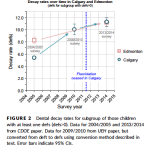Recently it has come to my attention that a notion to again Fluoridate Calgary’s water supply is being debated by City Council. I was most dismayed to see this again being debated, after Calgary successfully removed Fluoride from the water in 2011, on the basis of the need for costly plant upgrades to continue, and the rights of individuals to not be medicated against their will, as well as attention to the fact the Fluoride is not a substitute for dental care for poor children, which would be far more effective in preventing dental decay. The funding used to fluoridate water was redirected instead into a program of dental care for low income children.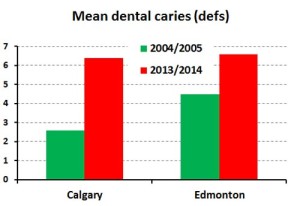
The catalyst for this reconsideration seems to be a study from the University of Calgary study by Mclaren et al. In this study they compared the number of cavities in grade two schoolchildren between Calgary, which stopped Fluoridation, and Edmonton, which continued it. The study was done in 2013-14, and a similar study in 2004-5 was used a control. The study results are displayed in graphical form to the right:
Now, this would seem to be quite an open and shut case. However, As recently discussed by Neurath et al in another article, this survey was however, somewhat odd in using older 2004-5 data, instead of a more recent 2009-10 survey 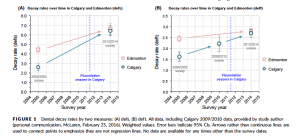 of dental health in Calgary. This 2009-10 survey was performed using the same methods, in fact being intended to be compared to the 2004-5 study, and it gives some remarkable results, as shown in the figure to the left (taken from page 3 of Neurath et al’s paper, and gratefully acknowledged).
of dental health in Calgary. This 2009-10 survey was performed using the same methods, in fact being intended to be compared to the 2004-5 study, and it gives some remarkable results, as shown in the figure to the left (taken from page 3 of Neurath et al’s paper, and gratefully acknowledged).
From Neurath’s data we can see that the vast majority of change in dental decay rates occurred before the cessation 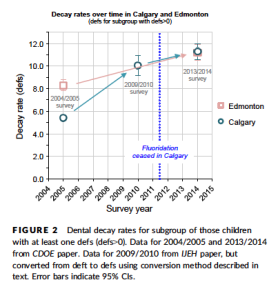 of fluoridation in the city. The rate of dental decay between 2009-10 and 2013-14 in fact, while showing an upward trend, were not statistically significantly different. Neurath also criticized Mclaren for equating Calgary and Edmonton, as Edmonton has always had considerably poorer health than Calgary, and at baseline Edmonton’s tooth decay rate was 73% higher, for reasons that are not clear, making comparisons between the two of limited value. There was also some potential for selection bias in the 2013-14 dental survey, and subgroup analysis, restricting analysis to children with at least one cavity in fact are even less persuasive than the all inclusive data, as shown in the figure to the right, again gratefully acknowledged as being taken from Neurath et al.
of fluoridation in the city. The rate of dental decay between 2009-10 and 2013-14 in fact, while showing an upward trend, were not statistically significantly different. Neurath also criticized Mclaren for equating Calgary and Edmonton, as Edmonton has always had considerably poorer health than Calgary, and at baseline Edmonton’s tooth decay rate was 73% higher, for reasons that are not clear, making comparisons between the two of limited value. There was also some potential for selection bias in the 2013-14 dental survey, and subgroup analysis, restricting analysis to children with at least one cavity in fact are even less persuasive than the all inclusive data, as shown in the figure to the right, again gratefully acknowledged as being taken from Neurath et al.
This paper was responded to by Mclaren who stated that the 2009-10 data were excluded due to the lack of a comparison survey in Edmonton, and due to the 2010 paper’s focus on whole tooth, rather than tooth surface data, and dispute several other factors in Neurath’s analysis.
Regardless of this, it can be seen that the case for fluoridation based on this single paper in Calgary is not particularly strong. Calgary and Edmonton ( and indeed most of the first world) is in the midst of a vast increase in dental decay, likely mediated by changes in diet. Fluoridation however, like all interventions on the human body, does not exclusively affect one organ to the exclusion of others. Fluoridation has systematic effects on the human body, outside of the teeth, and these must be taken into account.
A small subset of patients have reported clinically a negative effect on their thyroids from fluoridated water. Some research has examined this phenomenon and found no particular association between TSH levels and urinary Fluoride excretion. Aside from the issues of using TSH alone instead of a full range of thyroid lab values, other research has examined this phenomenon in light of the patients iodine status. In patients with lower Iodine status, according to this research, TSH increases, indicating an adverse effect on thyroid hormone secretion. As we can see from this data from statscan, a considerable percentage of Canadians have poor iodine status, and may have thyroid function lowered by water Fluoridation, particularly in inland areas such as Calgary, which tend to have lower iodine status.
Fluoridation of water was also associated in one study with lower rates of eye cancer, and in another with lower rates of kidney stones and bladder cancer.
The most contentious issue however remains the effect of Fluoride on children’s intelligence. A number of research studies have been done suggesting a strong correlation between Dental fluorosis and lowered IQ in Children. (see here, for a study on this topic in Bagalkot, and here for another done in Lucknow). In one metanalysis in 2012 Choi et all found an inverse association with Fluoride levels on water and children’s IQ, that is a higher levels of fluoride correlated with a lower IQ. This study has been criticized for including studies that looked at both Iodine and Fluoride status, as well as relying on naturally occurring levels of fluoride, rather than artificially supplemented by water fluoridation as well as other confounders, such as the association of water Fluoride with Arsenic contamination, and inability to determine the exact level of fluoride consumption when relying on general water concentrations. One such study, can be seen here, although it was not included in the 2012 metaanalysis. Another, grading children into high, medium and low Fluoride areas found the same negative correlation.
So, several more studies were done using much more precise measures. One in Mexico measured the urine concentration of Fluoride in pregnant women, and correlated it to their children’s cognitive test scores at age 4 and 6-12. This study found significant associations with higher Fluoride urine levels and lower performance on these cognitive tests resulting in a loss of roughly 6.13 loss in IQ for every 1mg/L increase in maternal fluoride excretion. Another study was performed using similar methods in Canada, finding a loss of 4.5 IQ points in boys for every 1mg/L, but none for girls. These last two studies overcame many of the specific problems with the 2012 metanalysis and seem to confirm the findings. To put this effect into context, high childhood lead exposure correlates with a 1.61 point loss of IQ in adulthood, and when this was found out, the result was international banning of leaded gasoline, paint and glazes. This reduction in lead in the 1970s is also hypothesized to be behind the decline in violent crime seen in the 1990s, again, with an IQ point drop that is approximately 1/3 that shown from fluoride.
Echoing the above research,and the emphasis on boys being more vulnerable to negative health outcomes from Fluoridation, another study in Mexico was performed based on urinary Fluoride excretion showing a later age of puberty in boys with higher Fluoride exposure.
Also recently, some speculation has emerged the Fluoridation in water sources, particularly in combination with aluminum exposure in utero may predispose individuals to develop autism. The evidence behind this hypothesis has not yet been thoroughly examined however.
Conclusions:
The above data do present a complex picture. The general literature, and I personally, accepts that increasing the level of Fluoride in water decreases dental cavities. However, Fluoride also has a complex and negative effect on Childhood intelligence, likely lowering the IQ of children of mothers exposed to high fluoride exposure by 4-6 points per extra mg/L of maternal fluoride excretion. To put this into context, the mass exposure of children to leaded paint and gasoline, which was hypothesized to be behind the Lead-Crime effect, showed an approximately 1.6 point IQ drop.
As well, as we can see with more complete data, while Calgary is experiencing an increase in dental cavities in children, this is likely due to much more complex factors than just the removal of Fluoridation from the cities water supply, as the majority of the increase, and possibly all of it, occurred before Fluoride was actually removed.
Fluoride itself is also extremely difficult to remove from water, requiring complex Reverse Osmosis equipment to fully remove. Other additives to water with negative health outcomes, such as Chlorine (associated with certain types of Cancers and disruption of the gut Microbiome) are not relevant, as chlorine is easily removed by inexpensive water filters, within reach of nearly all Calgarians, and the certain benefits of removing water borne pathogens from the water supply that Chlorine provides.
The cost of Fluoridation in a city that increasingly burdened by a shrinking tax base, particularly when Fluoridation is difficult to remove from the water and will have a strong adverse effect on intelligence in children, is not in the public interest of Calgary. The problem of increased dental cavities would best be solved by public coverage of dental medicine (which should be included in an expanded medicare system along with Naturopathic, Chiropractic, Traditional Chinese, and other medicines).
As some of you have no doubt read, Naturopathic medicine has recently come under considerable criticism in Canada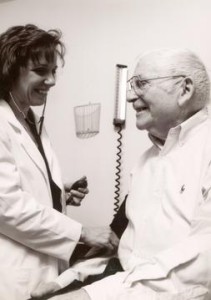 for lacking the extended residencies common in allopathic medical education.
for lacking the extended residencies common in allopathic medical education.
Naturopathic Doctors ourselves have long recognized, in our own private discussions within the profession, of the need for such a residency system. We are, in fact, nearly universally in favor of such a system. The reason one is not established however, is very simple. It is purely financial.
Naturopathic Medicine in Canada remains almost entirely outside of the systems of massive subsidies that exist for medical care. I recently uncovered a document published by the Government of Canada about a decade ago, containing two estimates of the cost of allopathic medical education. In the 2002 report of the Standing Senate Committee on “Social Affairs, Science and Technology, The
Health of Canadians – The Federal Role” the cost of medical education in Canada at that time was reported as $65 000 annually, or approximately $260 000 for a four year program, roughly $86 000 and $343 000 respectively in 2019 dollars, accounting for inflation. A second report, entitled “Rapport du groupe de travail sur le développement d’une formule d’analyse des propositions des institutions du CNFS en vue de la Phase III (2008-2013)” gives a slightly lower figure of between $45 000 and $73 500 in 2007 dollars, or approximately $54000-$87000 in 2019 dollars, adjusted for inflation, annually.
This however is only part of the cost of medical training in Canada. Postgraduate Medical training, or residency, is also heavily subsidized, like all aspects of medical care in the country, including both training and a salary. This too was studied by the above report. Medical residencies can be hard to compare, based on their different lengths and trainings, but we will focus on Family medicine, since it seems to be as directly comparable to Naturopathic medicine as possible in the two professions.
According to Public Health Agency of Canada’s 2005 Landscape of Community Medicine report, the cost of residency training in Alberta ranges in 2003-4 from $99 184 per year to $119 683 per year, or approximately $126 000 to $151 000 inflation adjusted to 2019 dollars. Let us use the lower estimates for comparison’s sake. For a two year family medicine residency, the total cost would be approximately $252 000.
In total, using lower cost estimates based on the above paper adjusted for inflation, we get subsidies of approximately $595 000 for the education of an allopathic physician in Canada. Afterwards of course allopathic doctors also receive the ability to bill provincial health agencies for their services. Medical tuition can vary widely between medical schools, so I have decided that my undergraduate University should serve as an entirely arbitrary model. Tuition at the U of C faculty of Medicine is 15012.18 annually for a three year program or $60 048.72. Tuition for postgraduate medical education is $485.23 per term, capped at $979.46 annually. These two sources together (assuming a two year residency) raise an additional $ 62 007.64. This brings the total funding for allopathic medical education to $657 000.
The tuition at my Alma mater, the Canadian College of Naturopathic medicine has tuition fees of, in 2019, $23 970. For a completed four year program, the cost is $95 880, all of which is paid by the student. Naturopathic medicine gets a few grants for research, but is almost entirely student supported.
These figures $657 000 versus $95 880, is the funding available for the medical education of each profession. Of this, Naturopathic is entirely private (even if provided from Student loans, which must be repaid) and all but approximately 62 000 is publicly funded, and never repayable for the student.
I of course have excluded the costs of Undergraduate, as well as supplies, textbooks and living expenses in this analysis. I’ve also excluded differentials in research funding allocations (spoiler, we get almost nothing in comparison).
As I said, Naturopathic medicine, in our own internal discussions, we have frequently alluded to our own need for residencies and other organized graduate medical education. The existence of such a residency in allopathic education is completely dependent on the approximately $600 000 subsidies each medical student gets.
If Naturopathic is expected to meet similar levels of education, we must be presented with similar levels of public funding.
Image Credit: https://commons.wikimedia.org/wiki/Medicine#/media/File:BloodPressure2.jpg
Hi everyone. Exciting news!!!
As those of you who follow my publications page already know, I just released my largest book yet! This book is on Amphibians and Reptiles, and shows the first homeopathic discussion of the Amphibians, Turtles, Crocodilians and even Dinosaurs!
You can purchase it by clicking here, or the ebook by clicking here.
Also I just received a very wonderful review by Rochelle Marsden of my book on Lophotrochozoa (mollusks and relatives). Thank you to Rochelle! It was lovely!
At the moment I am working very hard on a few presentations on research in Homeopathy, Drainage, and blockages to healing. I’m working very hard on publishing my next book, on blockages to healing, on the winter solstice.
Hope you all are enjoying the snow day!!!
So, after years of campaigning, the NHMRC of Australia has finally released the first draft of it’s infamous report on Homeopathy.
The second version was released to great media fanfare in 2015 generally proclaiming the end of Homeopathy. Over time, the HRI and others began exposing the serious and likely deliberate methodological issues in this report. Eventually they initiated Freedom of information requests, and discovered even more methodological irregularities. These are detailed in the following video.
In short the points wrong (taken with gratitude from the HRI) with this report were:
- NHMRC did the homeopathy review twice, producing two reports, one in July 2012 and the one released to the public in March 2015.
- The existence of the first report was not disclosed to the public – it was only discovered through Freedom of Information (FOI) requests.
- NHMRC say they rejected the first report because it was poor quality despite it being undertaken by a reputable scientist and author of NHMRC’s own guidelines on how to conduct evidence reviews.
- FOI requests have revealed that a member of NHMRC’s expert committee overseeing the review process – Professor Fred Mendelsohn – confirmed the first review to be high quality saying – “I am impressed by the rigor, thoroughness and systematic approach given to this evaluation [….] Overall, a lot of excellent work has gone into this review and the results are presented in a systematic, unbiased and convincing manner.”
- NHMRC said the results of the second report published in 2015 were based on a “rigorous assessment of over 1800 studies”. In fact results were based on only 176 studies.
- NHMRC used a method that has never been used in any other review, before or since. NHMRC decided that for trials to be ‘reliable’ they had to have at least 150 participants and reach an unusually high threshold for quality. This is despite the fact that NHMRC itself routinely conducts studies with less than 150 participants.
- These unprecedented and arbitrary rules meant the results of 171 of the trials were completely disregarded as being ‘unreliable’ leaving only 5 trials NHMRC considered to be ‘reliable’. As they assessed all 5 of these trials as negative, this explains how NHMRC could conclude that there was no ‘reliable’ evidence.
- Professor Peter Brooks, Chair of the NHMRC committee that conducted the 2015 review, signed conflict of interest form declaring he was not “affiliated or associated with any organisation whose interests are either aligned with or opposed to homeopathy”, despite being a member of anti-homeopathy lobby group ‘Friends of Science in Medicine’
- NHMRC’s guidelines state that such committees must include experts on the topic being reviewed, yet there was not one homeopathy expert on this committee.
One of the most noteworthy problems which emerged during HRI’s investigation was the fact that the report was completed twice. One draft was finished in 2012, and a completely separate team was assembled to then produce the second publicly released version of the report, in 2015.
The first draft was concealed from the public, to the extent it was only uncovered by the Freedom of information act requests of the HRI and an Australian Homeopathic Association. This report, which can be seen here, is all the more unique in that it’s conclusions were quite different than the 2015 version.
The 2012 Version found Promising C grade evidence of Homeopathy in 5 conditions, Fibromyalgia, Otitis Media, Post Operative Ileus, Upper Respiratory Tract Infections in Adults, and Side Effects of Cancer treatment.
Furthermore, commentary on the first page clairified the position of NHMRC on Homeopathy, that the 2015 report did not find no evidence for Homeopathy in general, merely no evidence for any specific condition, and that with the change in methodology discussed above.
The change between versions of reports is critical, and lends even more weight to the idea that the 2015 report engaged in outcome shopping, due to not wishing to find positive evidence for Homeopathy.
I will in the future explore this 2012 report, and compare it to the 2015 version much more extensively.
I also will be presenting a webinar on Homeopathy research in the near future! I hope you will be able to join me for it. More on that in the future!
Recently the BC college of pharmacists has opened comments on it’s policy of allowing the sale of homeopathic remedies in pharmacies by regulate members. I made a comment on this topic, which is reproduced below. I hope you all enjoy it!
If you would like to comment yourself, please do so at: https://www.bcpharmacists.org/readlinks/registrar’s-message-homeopathic-products-pharmacies?fbclid=IwAR187hD0GtQpWSXbF5ZkHTCBPVfIzplXoWt5Jnl47t-ZaLgsPBM2PPz0S8I
The belief that Homeopathy has no evidence is not a belief founded in fact. When one objectively and nondeceptively examines the homeopathic literature, one discovers that the overall balance of evidence, when considered without bias, is positive, both in terms of clinical trial literature, and in terms of the in vitro data. I reviewed the clinical trial data here:
https://ndnr.com/…/greater-than-placebo-a-critical…/
I have also reviewed the in vitro data in this blog post:
http://www.drpaultheriault.com/…/homeopathy-has-in…/
There currently is movement to ignore these sets of evidence, and to use instead ostracism and social stigma against homeopathy because it is not understandable within the worldview of allopathic medicine has taken root, including an increasing movement to deny legal access to Homeopathic remedies, which are without doubt incredibly safe medical interventions.
This movement is illegitimate. Homeopathy is safe, and is an excellent intervention in a wide range of conditions, and deserves a legal place in pharmacies.
Hi Everyone. I just had a new article published. It actually started on this blog as an article on the meta-analyses of clinical trials of Homeopathy. I updated it, and NDNR was kind enough to publish it!
Anyway, here is the Article. I hope you enjoy it!
https://ndnr.com/pain-medicine/greater-than-placebo-a-critical-review-of-homeopathy-research/
Take care of yourselves!
Hi Everyone. I was recently reading when I came across the following research newspaper summary.
I was fascinated by it. This was criticism, from a non Naturopathic source, which articulated a Naturopathic criticism of the allopathic system of disease that has existed for at least a century, and which was held by our forbears for centuries prior to the formation of Naturopathic Medicine.
To remind ourselves the principles of Naturopathic medicine are
- The body is a self regulating whole.
- Disease as an attempt of the vitality to restore balance within it’s whole self.
- Successful treatment of disease involves the stimulation of the bodies own self regulatory ability.
Allopathic medicine holds to different principles:
- The body is a complex machine
- Disease is a malfunction of the machine
- Successful treatment of disease is the return of the body to statistically normal function
These basics, while simple, lead to some profound differences in practice and all other aspects of Medicine, diagnosis perhaps most of all.
Allopathic medicine’s ideas about health and illness tend to also produce the concept of the diagnosis, the idea that there are entities, which we term diseases, that afflict people. Naturopathic medicine, in contrast recognizes common physiological processes which can become disordered in individuals, but places much less emphasis on entities. In allopathic medicine diagnosis leads to a treatment to treat diseases and return it’s functioning to normal. Naturopathic diagnoses tend to focus on physiological functions that have been disrupted, and, using homeopathy, the curative therapy. Naturopath’s diagnose a phosphorus pneumonia, a rumex cough, a calc carb diarrhea, and so forth.
The above article that I mentioned pointed out the futility of the allopathic system of diagnosis and treatment in the area of psychiatry. Diagnoses are overlapping and arbitrary, and bear no relationship to therapy. Diagnoses also conceal a number of common processes, such as developmental trauma, and I would also argue, developmental plateau and nutrient deficiency, common processes which contribute to many pathologies.
Allopathic therapies, based on drugs, electroshock therapy, and some psychotherapy, do not address these processes, by and large. Some noble and notable MDs have indeed spoken about about this, such as Gabor Mate, and Megan Rodway, have spoken on this, but the vast majority of practicing psychiatrists have not absorbed these insights. At the moment, only those rare MDs, and Naturopathic Doctors, are thier best option.
Hi Everyone. I have a new book releasing!
This is the 6th paperback volume of my Table of Animals Project, detailing the Hemichordates, Echinoderms ( starfish), Lampreys, Sharks, and Bony Fish. It is a lovely work, and I hope you all enjoy it.
You can purchase the physical book here, and the ebook here. 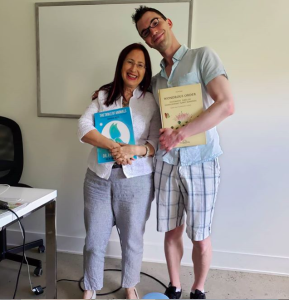
It was also most lovely to travel accross Canada this week to begin presenting some of my ideas. I was in Saskatoon to present on ideas of immunity and vitality, and in Montreal to present briefly on the relationship of the butterflies and plants and Michal Yakir’s teaching. This was particularly wonderful, and Michal inspired my own work with animals. We got along wonderfully, had a lovely trituration after the seminar, and then agreed to do some collaborative work. HEre is a phot of us holding each other’s books!
Anyway, I hope you Enjoy the books! Please do read them, and tell me what you think!
Take care of yourselves!
I hope you all had an excellent Naturopathic Medicine week in 2019!
As always, I will conclude the week with a blog post detailing the research into Naturopathic Medicine. Each year seems to bring new advances, which I am immensely grateful for. To begin with, we should discuss Naturopathic regulation globally, something that the World Naturopathic Federation has done wonderfully in the following paper. One of my own teachers, Dr. Mike Prytula, ND, has also made a lovely introductory video on Naturopathic Medicine.
To begin with, two reviews of all clinical trials on Naturopathic medicine have been conducted. The first was done in 2015, and found clinical trials on 13 conditions, finding statistically significant results in 10 of them. A second review conducted in 2019 found 33 trials, with Naturopathic medicine being found effective in pain, cardiovascular illness, type 2 diabetes, PCOS, depression and anxiety.
A newer review was also performed, specifically in regard to side effects of Naturopathic medicine and surgical practice. The reviewers found a number of potential benefits naturopathic treatment could have in relation to surgery that demand further study, and no reports of serious side effects present.
Naturopathic care in Cardiovascular disease was recently examined in a clinical trial. 246 postal workers received Naturopathic care (207 completed the study) in addition to normal family medicine from their MD. Lab chemistry was taken before and after Naturopathic care,and their risk of a major cardiovascular even was computed using the Framingham Risk Score method of computing the likelihood of a Cardiovascular event, and the Adult Risk Panel III to compute the prevalence of metabolic syndrome. One group in the study received Naturopathic care plus normal medical care, and another received only normal medical care. In this study a highly significantly reduced risk of a major cardiovascular event (risk reduction in control group of 10.81, risk in Naturopathic group of 7.74% for a reduction of 3.07%) and a reduction of metabolic syndrome (48.48% control group, 31.58% Naturopathic group for a reduction 16.9%).Naturopathic care in Cardiovascular disease was recently examined in a clinical trial. 246 postal workers received Naturopathic care (207 completed the study) in addition to normal family medicine from their MD. Lab chemistry was taken before and after Naturopathic care,and their risk of a major cardiovascular even was computed using the Framingham Risk Score method of computing the likelihood of a Cardiovascular event, and the Adult Risk Panel III to compute the prevalence of metabolic syndrome. One group in the study received Naturopathic care plus normal medical care, and another received only normal medical care. In this study a highly significantly reduced risk of a major cardiovascular event (risk reduction in control group of 10.81, risk in Naturopathic group of 7.74% for a reduction of 3.07%) and a reduction of metabolic syndrome (48.48% control group, 31.58% Naturopathic group for a reduction 16.9%).
This data was further analyzed in another paper for the economic impact of Naturopathic treatment. The above trial resulted in (corresponding to a 3.3% decreased risk of a Cardiovascular event) in a savings of $1138 in costs to society and $1187 in employer costs per year of Naturopathic treatment. The cost savings of livelong Naturopathic care that could be speculated on based on this remain staggering.
In response to this trial, this MD in CMAJ endorsed the idea of delegating some aspects of Cardiovascular care from Medical to Naturopathic Doctors. Many MDs would oppose this, but a significant minority of our Allopathic cousins would gladly cooperate with us in patient management.
Another Clinical trial on the Naturopathic treatment of rotator cuff tendonitis was recently published. In it, a group of postal workers with diagnosed rotator cuff tendontis received either a standard set of physiotherapy exercises to do on their own (an approach not unlike that which many MDs in family practice will use before a physiotherapy referral) as well as a matched placebo. Pain was measured using Shoulder pain and disability index scores, visual analogue pain score, Short form 36, and MYMOP. 87% of participants completed 8 weeks of treatment, SPADI scores decreased by 54.5% (p<0.0001) in the Naturopathic care group and 18% (p<0.0241) in the Exercise group. All measures showed significant differences in favor of Naturopathic care, with SPADI showing a difference probability of <0.0001 and no major adverse outcomes reported.
In a similar trial 75 postal employees with back pain greater than 6 weeks duration were given either Naturopathic medicine or standardized exercises ( again similar to what they might recieve at an MD practice) for 12 weeks. Progress was measured using the Oswestry disability questionaire, as well as the SF-36, lower back range of motion, weight loss and BMI. 92% completed at least 8 weeks of treatment. Back pain reduced significantly in the Naturopathic group (-6.92 on Oswestry, p<0.0001) and all other measure improved significantly as well.
The above trial was analyzed for economic impact. In the analysis, employees experienced 9.4 more perfect health days and reduced societal ( read employer) costs of $1212 per participant over the course of the study. The intervention cost $154 per day, compared with lost productivity costs of $178 per day, representing a return on investment of7.9%. Individuals participating saved $1096 each. Again this was from a single course of treatment. Imagine the cost savings applied society wide, particularly in countries like Canada with socialized medicine.
Another small Indian study showed significant improvements in PEFR, VC, FVC, FEV1, FEV/FEC%, MVV< ESR and Absolute Eosinophil count in Asthma patients undergoing a Naturopathic and Yogic treatment regimen.
In another study, patient outcomes from Naturopathic and Allopathic medical practices were compared in the treatment of menopausal symptoms. Consistent with other research, Naturopathic patients reported higher income, lower rates of smoking, higher rates of exercise, but interestingly, greater rates of fatigue, insomnia and hot flashes. Both patient groups resulted in improvements in anxiety, hot flashes, vaginal dryness and menstrual changes. Significantly better results were found in insomnia and fatigue.
One study was done on patients with Autism, 67 patients ranging from 3-58 years were given supplementation, with additional naturopathic treatments, such as enzymes, carnitine, epsom salts baths and a diet free of gluten, casein and soy. Lab results show a significant improvement of blood nutrient levels, and nonverbal IQ and autism symptoms also significantly improved.
Another study examines Polycystic ovarian syndrome patients who had undergone a Naturopathic and Yogic regimen for 12 weeks. 25 patients were given the intervention, while 25 others were placed on a wait list. Significant changes were observed in ovarian morphology and body measurements.
Recent Indian research has focused on a number of areas of integration of Naturopathic medicine and conventional care. This paper reviews the multiple ways many Naturopathic agents can aid in modulating cell signalling pathways in cancer. Another paper shows a similar conclusion, with Natural compounds showing great promise in decreasing resistance to one method of cell self destruction in cancers.
Much recent research has focused on the types of patients Naturopathic Doctors see. In one recent study a survey of 300483 visits to a Naturopathic teaching clinic was examined. It was found that Naturopathic clinics saw a similar range of problems to other primary care practices, that patients paid out of pocket more (unsurprisingly) and that Naturopathic clinics offered discounted care far more often.
Another recent study discussed characteristics of Pediatric patients coming to CCNM, a Naturopathic college in Toronto. Furthermore, a cross section of Naturopathic patients as a whole at CCNM was done, showing the incredibly wide variety of issues people come to Naturopathic Doctors with.
Another fascinating direction of research has emerged in the applications of Public health models of research to Naturopathic care, rather than more allopathic models a potential research enterprise with much potential. Another study measured the characteristics of rural Naturopathic practice in Australia, showing the important role played by naturopaths in the provision of underserved rural populations. Another study showed a high level of patient and staff satisfaction resulting from integration of Naturopathic medicine into an acute care hospital.
Perhaps most intriguingly in our survey of research is this paper, published in the Indian Journal of Medical Ethics. India is in the slow process of constructing a healthcare system of Universal coverage (often jokingly termed Modicare after the Indian Prime Minister Narendera Modi). Unlike in Countries such as Canada which have long traditions of public medicine that were built during the low point of Holistic medicine, in the 1960s, India likely will be including all systems of medicine in it’s public scheme, along with allopathic care. AYUSH is the term in India used for such systems, including Ayurveda, Therapeutic Yoga, Unani, Sidda, Homeopathy and Naturopathy. The above mentioned paper examined the AYUSH systems in light of a report on the Principles of Universal Care produced by the Planning Commission of India. In that paper, the authors conclude that not only does AYUSH meet the standards the India government wishes to see in it’s Universal system, they would actually further it’s goals more effectively in many cases than Allopathic care alone would be able to.
Finally, there is a free documentary showing Naturopathic medicine being practiced in India, to fully scope, in in-patient facilities. I encourage you to watch it. It is my hope that the example of India in medical equality and non discrimination will be followed by Canada and other Western countries, giving all citizens the potential for access to the benefits of Naturopathic Treatment.
Happy Naturopathic Medicine Week Everyone!
Hi Everyone. Apologies for not writing earlier. I am quite occupied by the writing of a new book on Blockages to healing, and a few other things.
But I did find time to write another article on the evidence behind Homeopathy is response to a particularly horrendous one published recently. It’s on my Publications page, and you can also find a link here.
Hope you all are doing well. I will again be doing my annual compilation of Naturopathic Research for Naturopathic Medicine week, which starts May 13th!
